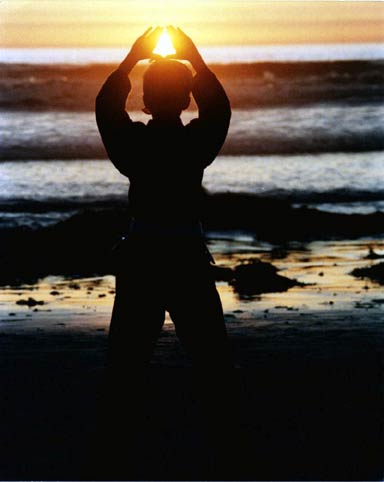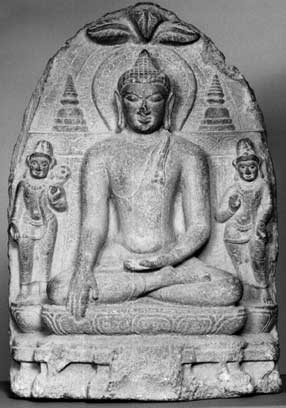

The gate to enlightenment lies before us,
Though we hesitate at the door
Let us draw up a comfortable cushion
And rest it on the floor.
--C.Alexander Simpkins
 Martial
arts have been linked to meditation since their very beginnings. The legendary
roots of the martial arts are attributed to the originator of Zen Buddhism,
Bodhidharma. Fiercely devoted to meditation, Bodhidharma was said to have sat
facing a wall in meditation for nine years. His reputation spread, and eventually
he began teaching this intense form of meditation at the Shaolin Temple. The
monks did not seem to be able to sustain their concentration. Bodhidharma recognizing
the problem, developed eighteen sets of movement to give the monks a way to
improve their mental focus. These exercises were the legendary beginnings of
martial arts. Once
the monks incorporated these movements into their meditation they found themselves
deeper in meditation than ever before. Thus the unity between martial arts and
meditation was born.
Martial
arts have been linked to meditation since their very beginnings. The legendary
roots of the martial arts are attributed to the originator of Zen Buddhism,
Bodhidharma. Fiercely devoted to meditation, Bodhidharma was said to have sat
facing a wall in meditation for nine years. His reputation spread, and eventually
he began teaching this intense form of meditation at the Shaolin Temple. The
monks did not seem to be able to sustain their concentration. Bodhidharma recognizing
the problem, developed eighteen sets of movement to give the monks a way to
improve their mental focus. These exercises were the legendary beginnings of
martial arts. Once
the monks incorporated these movements into their meditation they found themselves
deeper in meditation than ever before. Thus the unity between martial arts and
meditation was born.

Although meditation is implicitly part of martial arts, many styles do not directly incorporate meditation. This article will guide you in making meditation part of your life and your art.
See first with the mind, then with the eyes, and finally with the body and limbs. (Yagyu in Suzuki 1959, 165).
Getting Ready
Meditation is first of all an experience. The more you do it, the more natural it becomes. Theory is secondary. Practicing these meditations regularly, you share in a tradition that has enriched the lives of people around the world for centuries.
A Place to Meditate

People often ask, Where should I meditate? The atmosphere of the place you choose can be very helpful, although once you are well acquainted with meditation, you can do it almost anywhere. At first, find a quiet place to meditate. It may be a quiet room or even a certain corner in your house. Set up the area with a meditation pillow for sitting and a mat to lie down on. Lighting should be subdued, not too dark or too bright. Some people also like to burn incense or bring in a fragrant or lush plant. Keep it simple, but give it atmosphere. Zen tea rooms are traditionally decorated naturally and simply to create an atmosphere of sanctuary. A single flower in a vase, and a lone calligraphic scroll hanging on a blank wall are usually the only decorations. Pillows on a wooden floor make up the furnishings: quiet surroundings to foster a quiet mind. Nature can be inspirational for meditation.
Meditation done outdoors, at a park, in the woods, or perhaps in a beautiful garden can help to bring about a feeling of Oneness. Water can also have a calming effect. The beach, the shore of a lake, the edge of a pond, or the banks of a stream can all be possible sites for a meditation session. Some of the meditations included in this book are best done outdoors. Often people choose to meditate with a group. Sometimes the commitment and momentum of many people embarking on meditation together, striving for enlightenment, can carry you along. Others prefer solitude and privacy, feeling that the group atmosphere is distracting. Whether you choose to meditate with others or alone is a matter of personal preference. There are many meditation centers and retreats springing up all around the world. They offer from hour-long up to month-long retreats for regular meditation. Yet, your own personal, private experience, alone or with someone may be complete.
There are no prerequisite conditions, but one: meditate! Meditation can even be done in the middle of a busy downtown area. In Tokyo, "meditation cafes" offer popular places to go for quiet moments. Speaking is not allowed; even when ordering, customers just point to the items on the menu. All the tables and high-backed chairs face the same direction, so that each customer can enjoy privacy. Patrons relax and calm their mind, while savoring a delicious cup of tea or coffee (Wachter, 1994). The most important consideration in choosing a place to meditate is that you feel at ease there. Return to the same place each time for meditation. Habit and consistency help. Eventually you will find that meditation's blessings flow very naturally in your special meditation place.
The next consideration is when to meditate. A Time to Meditate Whenever we have given a lecture on meditation, people complain that their lives are too hectic and busy already and that they could not imagine finding any time at all to meditate. They are always surprised to discover that meditation can be done in as short a period as one minute and still bring positive effects! How much time you devote to meditation is a very personal matter. Undoubtedly there are wasted moments in your day or evening that you can make use of. A beginner can start off with one or two minutes a day and work up to a half hour, but even ten minutes a day can be effective. The unconscious, inner mind does not function on clock time the way our conscious mind does. Sometimes the deepest meditative experience occurs in a flash. Then again, an insight may evolve over many months of meditative practice. Meditate at least one time nearly every day. Start from where you are, devoting the time that you can comfortablely fit within your schedule, whatever you can do. You may discover a new capacity to use time emerges. But above all, meditate regularly! Be faithful to your practice.
Meditation Instructions

Meditation's calm
The sweet incense it brings
Restores us to peaceful Inner wellsprings
Helps us shed all cares
Cools and soothes the soul
Clears the mind Makes us whole.
--C. Alexander Simpkins
Meditation One: Focus on Breathing
Find a comfortable position. Close your eyes and breathe normally/ Turn your attention to your breathing. Notice how the air goes in through your nose, down into your lungs and then out again. Follow each breath, focusing all your attention on breathing in and out. If your attention wanders away, return your attention to breathing as soon as you can. Stay quietly sitting for one minute and increase the time as you are able. You may discover that even a minute or two of meditation each day can have positive benefits.
Meditation Two: Clearing the Mind
One of the great traditions of Zen meditation is clearing the mind. Begin by sitting comfortably either on the floor, on a pillow, or if floor-sitting is uncomfortable, sit on a chair. Close your eyes and sit quietly. Think of nothing, but don't think anything about it. If you find yourself carried away by thoughts, gently bring yourself back to thinking of nothing. Don't force yourself, just try to let go of thinking. Relax as you sit quietly for one minute. Increase the time as you are able. You will find that the flow of thoughts begins to slow down and eventually stop to give you a calm, clear meditative moment!
Fundamental, simple postures are most conducive to meditation: sitting, standing, and lying down. Once you can meditate comfortably when you are still, you can extend the meditative mind-set into more aspects of daily life, such as when you are in motion, and doing things. Take a moment while you are walking around in a store or moving about in your house to notice your breathing or clear your mind. Everything you do and experience can be an opportunity for deeper experience, more challenging practice.
For more detailed information on meditation,
click here: MEDITATION SITE
Back to Main Page / Interesting Links / Book Corner / Photos / Events / E-mail us